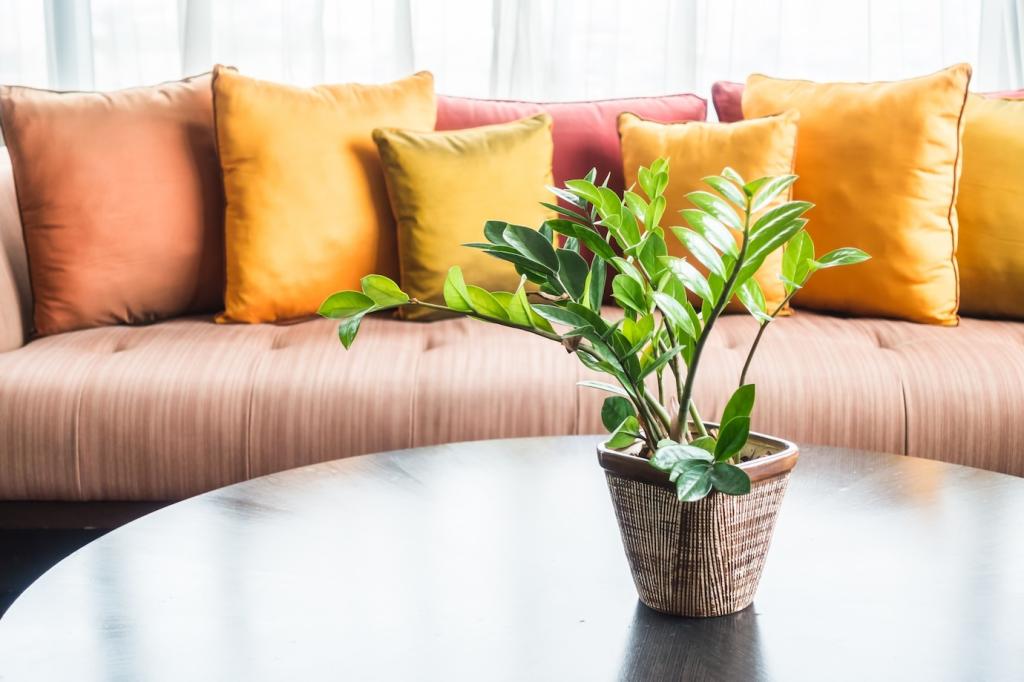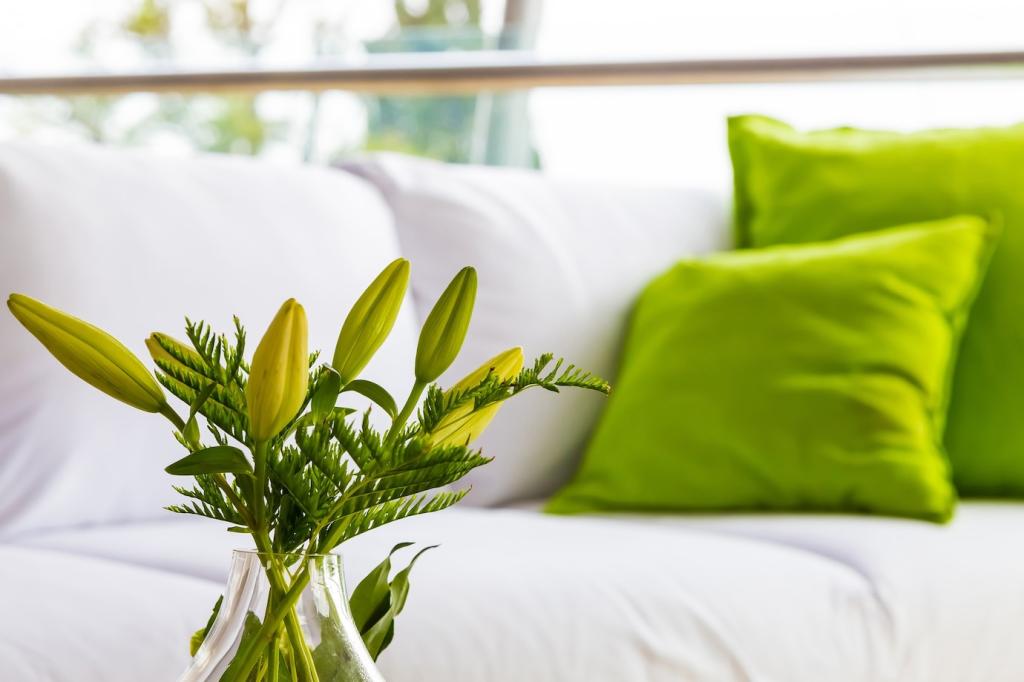Sustainable materials are at the heart of modern eco-friendly interiors, offering a balance between aesthetics, comfort, and environmental responsibility. Thoughtful selection of sustainable materials supports not only a healthier indoor space but also contributes positively to global ecological efforts. This page explores various aspects, innovations, and benefits of incorporating sustainable materials into interior design, providing inspiration for homes, offices, and commercial spaces. Each section delves into different facets, demonstrating how eco-friendly interiors can harmoniously blend style and ethics through mindful material choices.
The use of sustainably sourced materials helps minimize environmental degradation by reducing deforestation, pollution, and energy use in manufacturing processes. Materials like reclaimed wood, recycled metal, and plant-based composites require less energy and produce fewer greenhouse gases compared to their conventional counterparts. The thoughtful sourcing of these materials, including certification schemes and responsible suppliers, ensures the preservation of natural habitats and biodiversity. For eco-friendly interiors, reducing environmental impact also means supporting the regeneration of resources and investing in the planet’s future well-being while achieving beautiful and functional spaces.
The Importance of Sustainable Choices in Interior Design
Previous
Next
Bamboo: Versatile and Rapidly Renewable
The Environmental Advantages of Bamboo
The unrivaled growth rate of bamboo means it can be replenished with minimal environmental impact, helping to curb deforestation and land degradation. Bamboo’s deep-root system helps stabilize soil and prevents erosion, while its cultivation generally requires no pesticides or irrigation. As a carbon sink, bamboo absorbs significant amounts of CO2 during its growth cycle, actively mitigating greenhouse gas emissions. When responsibly sourced from well-managed plantations, bamboo stands as a symbol of regeneration and resilience in eco-conscious interiors.
Applications of Bamboo in Interiors
Bamboo lends itself to a broad range of interior applications, thanks to its hardness, durability, and natural beauty. Its uses span flooring, wall panels, cabinetry, furniture, and even decorative accents. Bamboo surfaces exhibit distinctive grain patterns and textures, infusing warmth and sophistication into both contemporary and traditional settings. Its versatility extends to engineered products like strand-woven bamboo, offering higher density and stability for high-traffic areas or demanding design applications. With careful treatment and finishing, bamboo remains robust, stain-resistant, and easy to maintain.
Responsible Sourcing and Certification
Despite bamboo’s impressive sustainability record, responsible sourcing is crucial to avoid ecological or social harm associated with intensive monocropping or habitat loss. Third-party certifications, such as FSC for bamboo, ensure that products have been harvested and processed under stringent guidelines. Transparency in the supply chain supports fair labor practices and sustainable land use. Homeowners and designers are encouraged to research suppliers and opt for certified bamboo to guarantee that their interiors contribute positively to both people and planet.

Recycled Materials: Giving Waste New Life
01
Recycled Glass Surfaces
Recycled glass offers a vibrant and durable alternative for countertops, tiles, and decorative features. By utilizing post-consumer bottles, jars, or industrial glass waste, manufacturers can create stunning terrazzo-like surfaces rich in color and texture. Recycled glass products are non-porous, easy to clean, and resistant to stains, making them a practical choice for kitchens and bathrooms. Their translucency and luminescence add depth and visual intrigue to interiors, giving designers a sustainable material that does not compromise on style or functionality.
02
Recycled Metal Elements
Scrap metal salvaged from automobiles, construction debris, or industrial waste is being creatively reincorporated into interior spaces. Recycled aluminum, steel, brass, and copper retain the strength and aesthetic qualities of virgin material, while requiring far less energy to process. These metals find new purpose as lighting fixtures, furniture frames, hardware, and accent pieces, each imbued with a sense of industrial chic. By giving metals a second life, designers conserve finite mineral resources and celebrate the circular economy within the home or office environment.
03
Textiles from Recycled Fibers
The textile industry has seen significant progress in adopting recycled fibers, converting plastic bottles, worn garments, or factory offcuts into new fabrics and upholsteries. Recycled polyester, nylon, and even natural fiber blends offer the softness, resilience, and color variety needed for cushions, rugs, drapery, and wall coverings. By reducing landfill waste and minimizing water and chemical use, these textiles demonstrate how comfort and sustainability can go hand in hand. For eco-friendly interiors, selecting furniture or accessories made from recycled fibers is a tangible commitment to a more circular and less wasteful world.
Cork Flooring and Wall Coverings
Cork is sustainably harvested by carefully stripping the bark from mature cork oak trees every nine to twelve years. This method causes no permanent damage, allowing the tree to regenerate its bark and continue absorbing carbon dioxide. The longevity of cork trees, which can live for over 200 years, translates into multiple harvests throughout their lifespan. Sustainable cork production supports local economies, preserves ancient woodlands in Mediterranean regions, and maintains important habitats for wildlife—making it a powerful example of renewable material sourcing.
Cork’s cellular structure contains millions of air pockets, giving it outstanding resilience, compressibility, and natural sound absorption. Cork floors provide cushioned comfort underfoot, reducing fatigue and providing warmth, which is particularly appreciated in kitchens and living areas. When used as wall panels, cork also enhances acoustic performance by dampening echoes and creating quieter, more peaceful environments. These qualities make cork ideal for residential, office, or hospitality spaces where comfort and tranquility are valued.
Cork is naturally resistant to mold, mildew, and pests, which contributes to its durability and ease of maintenance in interior environments. Its resilient surface recovers from minor impacts, while seals and finishes further protect it from stains or moisture. Properly maintained cork floors or walls can last for decades, maintaining their appearance and performance over time. With a gentle cleaning routine and periodic sealing, cork proves to be not only an ecological choice but also a high-return investment in sustainable, low-maintenance interiors.
Low-Impact Paints and Natural Finishes
Zero-VOC and Natural Paints
Paints with zero or ultra-low volatile organic compounds (VOCs) are formulated to release minimal airborne toxins during application and drying. These products drastically improve indoor air quality by eliminating common irritants and allergens, making them a safer choice, particularly for homes with children, elderly, or sensitive individuals. Natural paints made from clay, lime, casein, or plant oils rely on renewable resources, providing breathability and subtle matte finishes. The resulting color palette tends to be earthy and harmonious, enhancing the overall sense of wellness in a space.
Waxes and Oil-Based Finishes
Natural waxes and plant-derived oils offer an eco-friendly alternative to synthetic varnishes or polyurethane sealants. Products such as beeswax, carnauba wax, linseed oil, and tung oil provide effective protection for wood and other surfaces while highlighting their inherent grain and character. These finishes are biodegradable, derived from renewable resources, and typically do not emit toxic fumes. They also allow for easy spot-repair, prolonging the life of furniture, floors, and joinery without the need for extensive refurbishing or chemical-laden treatments.
Sustainable Wall Coverings
Wall coverings made from natural papers, grasscloth, cork, or hemp fibers can be installed using non-toxic adhesives, adding both texture and warmth to interiors. These materials are generally biodegradable and sourced from rapidly renewable or recycled content. Many natural wall coverings provide additional functional benefits, such as regulating humidity or improving acoustic comfort. Their tactile surfaces and organic patterns can transform any room, bringing the visual serenity and integrity associated with eco-conscious design.
Mycelium Composites
Mycelium, the root network of fungi, has stunning potential as a building and design material. Grown in molds using agricultural byproducts as a substrate, mycelium composites can be tailored for applications ranging from acoustic panels to furniture or decorative tiles. Upon completion of their useful life, mycelium-based products can be composted, returning nutrients to the soil. Mycelium is fire-resistant, lightweight, and insulating, offering new possibilities for healthy, innovative, and truly sustainable interiors.
Bioplastics from Renewable Sources
Bioplastics are derived from renewable sources such as cornstarch, sugarcane, or algae, offering a biodegradable alternative to petroleum-based plastics. In interior applications, bioplastics are molded into lighting fixtures, panels, countertops, and decorative accessories with minimal reliance on fossil fuels. Their biodegradability means they can break down naturally at the end of their lifecycle, reducing landfill accumulation. The versatility and potential of bioplastics are continuously growing, providing a bridge between modern convenience and sustainable responsibility.
Plant-Based Fabric Innovations
Advancements in textile technology have led to plant-based fabrics made from sources like hemp, flax, pineapple leaves, and even banana fibers. These fabrics are rapidly renewable, requiring little water or pesticide input, and are biodegradable at the end of their life. Plant-based textiles often boast natural antibacterial, breathable, and hypoallergenic properties, making them a comfortable and health-conscious choice for upholstery, bedding, and curtains. Their varied textures and earthy colors add a subtle richness to eco-focused interiors.

The Future of Eco-Friendly Interiors
The integration of smart technology into sustainable materials is unlocking a host of new capabilities. Thermally adaptive finishes, phase-changing materials for energy management, and self-healing surfaces are reshaping how interiors operate and respond to user needs. These next-generation materials are designed to minimize maintenance, extend longevity, and adapt to changing environments, further lowering the environmental footprint over time. Such innovations align seamlessly with green building goals, offering interiors that are as intuitive and low-impact as they are beautiful.
